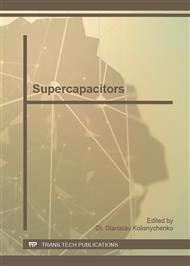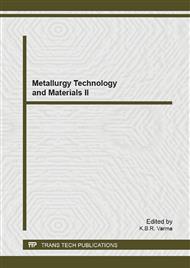[1]
P. Simon and Y. Gogotsi: Materials for electrochemical capacitors. Nat Mater (2008), pp.34-47.
Google Scholar
[2]
J.H. Huang, Y.S. Chen, C.C. Chuang and Y.M. Wong: Effect of Ti interlayer on the growth of carbon nanotubes on Si by microwave-heated chemical vapor deposition. Journal of Vacuum Science and Technology (2005), pp.805-808.
DOI: 10.1116/1.1861032
Google Scholar
[3]
S. Bellucci: Carbon nanotubes: physics and applications. Physica Status Solidi (2005), pp.34-47.
Google Scholar
[4]
A.C. Dillon, K.M. Jones and T.A. Bekkedahl: Storage of hydrogen in single-walled carbon nanotubes. Nature 386 (1997), pp.37737-37739.
Google Scholar
[5]
B.C. Satishkumar, A. Govindaraj and C.N.R. Rao: Bundles of aligned carbon nanotubes obtained by the pyrolysis of ferrocene–hydrocarbon mixtures: role of the metal nanoparticles produced in situ. Chemical Physics Letters (1999), pp.158-162.
DOI: 10.1016/s0009-2614(99)00521-7
Google Scholar
[6]
H.D. Abruña, Y. Kiya and J.C. Henderson: Batteries and electrochemical capacitors. Physics Today (2008), pp.1-7.
Google Scholar
[7]
T.F. Hsieh, C.C. Chuang, W.J. Chen and J.H. Huang: Hydrous ruthenium dioxide/multi-walled carbon-nanotube/titanium electrodes for supercapacitors. Carbon (2012), pp.1740-1747.
DOI: 10.1016/j.carbon.2011.12.017
Google Scholar
[8]
B. Xu, F. Wu, S. Chen and C.H. Zhang : Activated carbon fiber cloths as electrodes for high performance electric double layer capacitors. Electrochim Acta (2007), pp.4595-4598.
DOI: 10.1016/j.electacta.2007.01.006
Google Scholar
[9]
K.R. Prasad and N. Munichandraiah: Fabrication and evaluation of 450F0 electrochemical redox supercapacitors using inexpensive and high-performance polyaniline coated, stainless-steel electrodes. Journal Power Sources (2002), pp.443-451.
DOI: 10.1016/s0378-7753(02)00419-6
Google Scholar
[10]
E.G. Bushueva, P.S. Galkin, A.V. Okotrub and L.G. Bulusheva: Double layer supercapacitor properties of onion-like carbon materials. Phys Status Solidi (2008), pp.2296-2299.
DOI: 10.1002/pssb.200879608
Google Scholar
[11]
S. Park, K. Lian and Y. Gogotsi: Pseudocapacitive behaviour of carbon nanoparticles modified by phosphomolybdic acid. Journal of Electrochem Soc (2009), pp.921-926.
DOI: 10.1149/1.3223964
Google Scholar
[12]
Plonska-Brzezinska, E. Marta, A. Palkar and K. Winkler: Electrochemical properties of small carbon nano-onions films. Electrochem Solid State Lett (2010), pp.35-38.
DOI: 10.1149/1.3299252
Google Scholar
[13]
D. Pech, M. Brunet, H. Durou and P.H. Huang: Ultrahigh-power micrometre-sized supercapacitors based on onion-like carbon. Nat Nanotechnol( 2010), pp.651-654.
DOI: 10.1038/nnano.2010.162
Google Scholar



